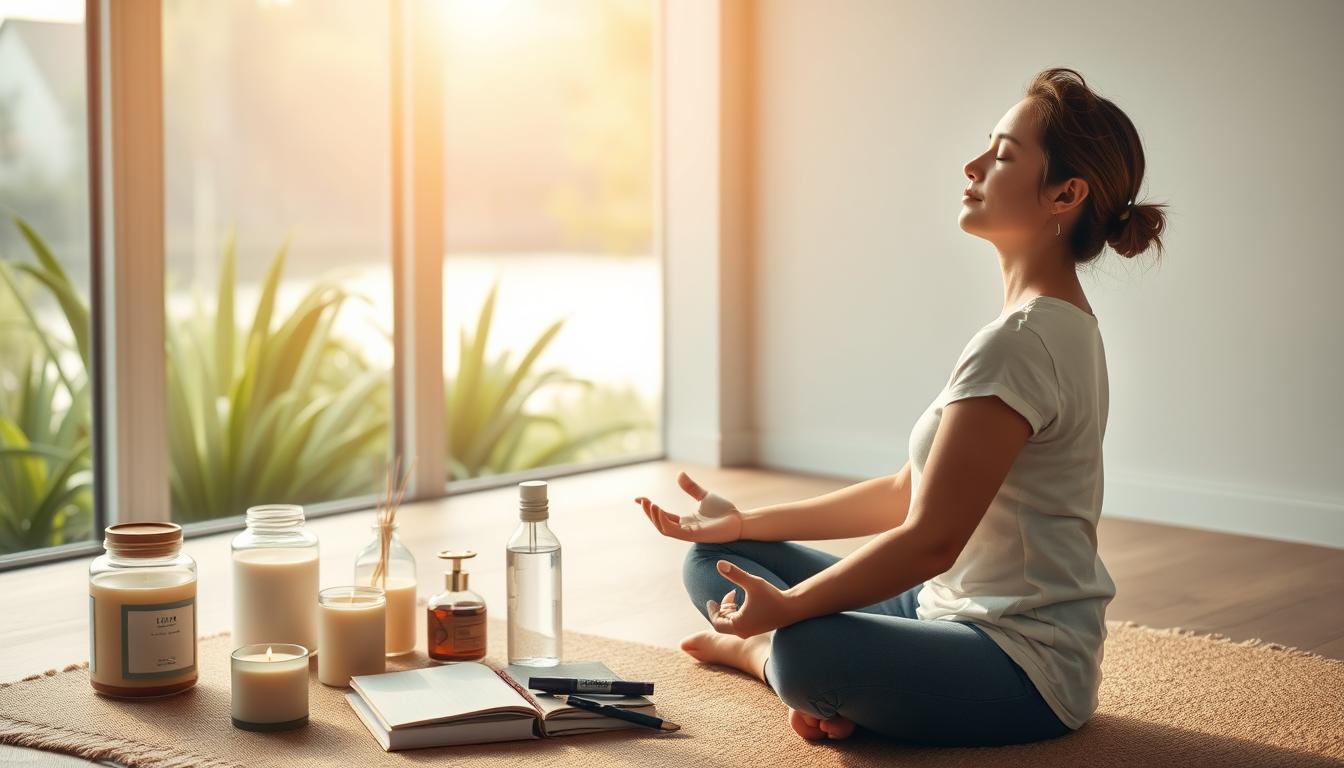I remember when everything changed for me. I was burnt out, exhausted, and drained. I realized my approach to stress management was failing.
The constant digital noise, work stress, and emotional demands were taking a toll. They were eroding my inner peace.
Learning how to protect your energy isn’t just a luxury; it’s a survival tactic in today’s world. Effective stress management is key to keeping your mind and emotions healthy. I found that taking intentional steps to protect your energy changed my life.
The modern world throws us many emotional and mental hurdles. To protect your energy doesn’t mean hiding away—it means setting healthy boundaries that safeguard your mental health and personal power.
Key Takeaways
- Recognize stress as a significant personal health challenge
- Understand that energy protection is a proactive strategy
- Learn to set clear personal boundaries
- Prioritize mental and emotional self-care
- Develop personalized stress management techniques
Understanding Energy Vampires and Their Impact
In my years of exploring stress management, I’ve found a key part: fighting energy vampires. These are people, situations, or habits that take away our mental and emotional energy. They leave us feeling drained and tired.

Energy vampires take many forms, each draining our emotional energy in different ways. Let me guide you in spotting these subtle drains on your emotional health.
Common Types of Energy Drains
- Chronic complainers who always talk about the negative
- Manipulative people who create drama and emotional mess
- Passive-aggressive friends or coworkers who undermine your confidence
- Relationships that ask for too much emotional effort
Recognizing Toxic Relationships
Not all relationships help us protect our energy. Some can feel like emotional quicksand, pulling us down and using up our mental energy. Trust your intuition if a relationship always feels draining.
Signs Your Energy Is Being Depleted
- Feeling tired all the time after being around others
- Getting anxious or stressed just thinking about certain people
- Seeing a pattern of emotional exhaustion
- Feeling less of yourself after social events
By knowing and spotting these energy vampires, you can start managing stress better. This helps protect your mental health.
Creating Healthy Boundaries for Energy Protection
Protecting energy is not just a concept; it’s a survival skill in today’s fast world. I’ve found that setting clear boundaries is key for managing stress and keeping well.
Creating healthy boundaries takes practice. Here are some strategies I’ve learned:
- Know your energy limits
- Tell others what you need clearly and kindly
- Say “no” without feeling bad about it
- Make self-care a must-do
Understanding different types of boundaries can change your life. Professional boundaries help avoid burnout at work. Personal boundaries protect your emotional health.
“Your personal energy is your most valuable resource. Protect it fiercely.”
My journey showed me that managing stress starts with knowing where to draw lines. Boundaries with colleagues, family, or friends help you grow and stay emotionally strong.
- Begin with small steps in setting boundaries
- Stick to them consistently
- Be kind to yourself while setting them
- Check and change your boundaries as needed
Creating boundaries isn’t about building walls. It’s about making healthy, respectful spaces that support your mental and emotional health.
The Science Behind Energy Protection and Mental Well-being
It’s key to grasp how our brains handle stress to keep our mental energy safe. Our brains are complex, always reacting to what’s around us. Stress is a big part of how we feel overall.

Neuroscience gives us cool insights into stress’s effect on our brain. Long-term stress can lead to many problems:
- Too much cortisol messes with our brain’s normal work
- Our brain’s pathways get too busy
- We lose the ability to think clearly
Neurological Effects of Stress
Long stress makes our brain’s amygdala work too much. This part of the brain handles our emotions, making us feel more anxious. It also makes it harder to keep our energy safe. Stress can even change how our brain works, making us more open to emotional problems later on.
How Energy Protection Impacts Brain Chemistry
Using smart ways to manage stress can change our brain’s patterns. Mindful practices help our brain adapt better to stress. This makes us more resilient against future emotional challenges.
Research-Backed Benefits of Energy Shielding
Studies show energy protection has real benefits:
- Less cortisol means a healthier brain
- We can handle our emotions better
- Our thinking gets sharper
- We feel better mentally
By learning and using energy protection methods, we can change how our brain reacts to stress.
Essential Stress Management Techniques for Daily Life

Dealing with daily stress can be tough. But, I’ve found some great ways to handle it. Mindfulness tips are not just buzzwords. They’re real tools to help you find peace in your mind.
Here are some quick and effective ways I manage stress:
- 5-Minute Breathing Reset: When stress comes, stop and breathe deeply. Inhale for 4 seconds, hold for 4, then exhale for 4. This helps your body relax.
- Micro-Meditation Moments: Make mindfulness a part of your day. Just 60 seconds of focused breathing can lower stress a lot.
- Physical Stress Release: Shake off stress. Try jumping jacks, stretching, or a quick walk to release tension.
Managing stress isn’t about avoiding it. It’s about learning to handle it well. By using these mindfulness tips, you can stay balanced and focused, even when things get tough.
“Stress is not what happens to us. It’s our response to what happens.” – Kelly McGonigal
Building stress management skills takes time and effort. Start with small steps, stay consistent, and see how these techniques can change your mind.
Mindfulness Practices for Energy Preservation

Understanding mindfulness is key to protecting your energy. Simple mindfulness tips can change how we see the world. These practices help keep our minds and emotions balanced.
Meditation Techniques for Beginners
Meditation is easy to start. Here are some simple steps:
- Find a quiet space where you won’t be interrupted
- Start with 5-minute sessions and gradually increase duration
- Use guided meditation apps for support
- Focus on your breath and gently redirect wandering thoughts
Breathing Exercises for Instant Calm
Managing stress can be as simple as breathing right. The 4-7-8 breathing technique has helped me a lot:
- Inhale through your nose for 4 seconds
- Hold your breath for 7 seconds
- Exhale slowly through your mouth for 8 seconds
- Repeat 4-5 times
Mindful Movement Practices
Mindful movement can greatly reduce stress. Yoga and tai chi are great for connecting body and mind. They improve flexibility and bring peace and energy.
“Mindfulness is a way of befriending ourselves and our experience.” – Jon Kabat-Zinn
Digital Detox: Protecting Your Energy Online

In today’s world, keeping our energy safe is harder than ever. The constant digital noise can harm our mental health. It’s vital to manage stress to stay balanced.
I’ve found ways to protect my energy from digital overload. Too many notifications, emails, and social media can drain our minds. Setting limits on tech use helps keep our emotions strong.
- Set specific tech-free zones in your home
- Establish daily digital curfews
- Use app-blocking tools to limit screen time
- Practice mindful scrolling
Thinking of digital use as a diet helps. We watch what we eat, and we should watch what we click online. Choose wisely, unfollow stressors, and focus on meaningful digital interactions.
Digital detox isn’t about complete elimination, but intentional engagement.
Managing stress in the digital age takes effort. By using these tips, you can take back your mental space. This way, you protect your energy from the constant online buzz.
Physical Ways to Shield Your Energy

Protecting energy isn’t just about mental strategies. Our physical habits are also key in managing stress. Our body’s wellness directly affects our energy levels and how well we bounce back.
Our physical approach to protecting energy includes three main areas:
- Strategic exercise routines
- Quality sleep patterns
- Nutritional support
Exercise and Movement
Regular physical activity is a strong tool against stress. I’ve seen that exercise helps release tension, boosts endorphins, and acts as a natural shield. Short, intense workouts like HIIT or yoga can greatly help protect energy.
“Movement is medicine for creating change in a person’s physical, emotional, and mental states.” – Carol Welch
Sleep Optimization
Getting quality sleep is essential for protecting energy. I aim for 7-9 hours of uninterrupted rest each night. I also keep a consistent sleep schedule. A relaxing bedtime routine and avoiding screens before bed help my body’s energy rhythms reset.
Nutrition for Energy Protection
Your diet is crucial for managing stress and keeping energy up. I eat whole foods, stay hydrated, and aim for balanced nutrition. Foods that boost energy include:
- Leafy green vegetables
- Lean proteins
- Complex carbohydrates
- Omega-3 rich foods
Remember, protecting your energy is a holistic journey that requires consistent physical and mental care.
Creating an Energy-Protective Morning Routine

Protecting energy begins when you wake up. My journey with mindfulness has shown me that starting your day right is key. A good morning routine can shield you from stress and emotional drain.
I’ve created a simple yet effective morning ritual. It helps me keep my energy and stay focused. Here’s what it includes:
- Wake up 15 minutes earlier than usual
- Hydrate immediately with a glass of water
- Practice 5-minute meditation
- Write three gratitude statements
- Stretch or do light movement
Mindfulness is essential for safeguarding your energy. Start with a breathing exercise. Close your eyes, breathe deeply, and imagine a shield of protection around you. This mental shield blocks negativity and sets a positive tone for the day.
Your morning routine is a personal sanctuary of renewal and strength.
Make your routine fit your life. Everyone’s schedule and preferences are different. The important thing is to be consistent and prioritize self-care, even if it’s just a few minutes.
- Listen to your body
- Be flexible with your approach
- Stay committed to your practice
Protecting energy isn’t about being perfect. It’s about building a practice that supports your mental and emotional health.
Conclusion
Exploring stress management has taught me that protecting energy is key. It’s not just a luxury but a survival skill in today’s world. By using mindfulness tips and energy protection strategies, we can face daily challenges differently.
Protecting energy needs regular practice and self-awareness. Simple steps like setting boundaries, meditating, and taking digital breaks can lower stress. These actions help us grow slowly but surely.
The biggest lesson is that we control our mental and emotional resources. By managing stress intentionally, we regain our power and well-being. Our world needs resilience, and these strategies help us stay strong.
I urge you to start protecting your energy today. Choose a method that feels right to you and practice it often. See how it changes your life. Your mental health and energy are priceless—value them as your most important assets.
FAQ
What exactly are energy vampires?
How can I quickly protect my energy in a stressful situation?
Can digital technology really impact my energy levels?
What are some beginner-friendly mindfulness practices?
How does nutrition impact energy protection?
How can I create an energy-protective morning routine?
What are the signs that my energy is being depleted?




